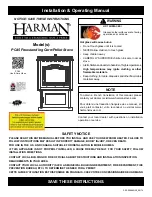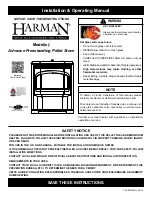
16
Ussc
TYPE
WEIGHT
(LBS. CU. FT., DRY)
PER CORD
EFFICIENCY
RANKING
SPLITS
MILLIONS
BTU’s/CORD
Hickory
63
4500
1.0
Well
31.5
White Oak
48
4100
.9
Fair
28.6
Red Oak
46
3900
.8
Fair
27.4
Beech
45
3800
.7
Hard
26.8
Sugar Maple
44
3700
.6
Fair
26.2
Black Oak
43
3700
.6
Fair
25.6
Ash
42
3600
.5
Well
25.0
Yellow Birch
40
3400
.4
Hard
23.8
Red Maple
38
3200
.3
Fair
22.6
Paper Birch
37
3100
.3
Easy
22.1
Elm/Sycamore
34
2900
.2
Very Diffi
cult
20.1
Red Spruce
29
1800
.1
Easy
16.1
WOODSTOVE UTILIZATION
Your heating unit was designed to burn wood only; no other materials should be burned. Waste and other fl ammable materials
should not be burned in your stove. Any type of wood may be used in your stove, but specifi c varieties have better energy yields
than others. Please consult the following table in order to make the best possible choice.
It is EXTREMELY IMPORTANT that you use DRY WOOD only in your wood stove. Th
e wood should have dried for 9 to 15 months,
such that the humidity content (in weight) is reduced below 20% of the weight of the log. It is very important to keep in mind that
even if the wood has been cut for one, two, or even more years, it is not necessarily dry if it has been stored in poor conditions. Under
extreme conditions it may rot, instead of drying. Th
is point cannot be over stressed; the vast majority of the problems related to the
operation of a wood stove is caused by the fact that the wood used was too damp or has dried in poor conditions. Th
ese problems can be:
- ignition problems
- creosote build-up causing chimney fi res
- low energy yield
- blackened windows
- incomplete log combustion
Smaller pieces of wood will dry faster. All logs exceeding 6” in diameter should be split. Th
e wood should not be stored directly on
the ground. Air should circulate through the cord. A 24” to 48” air space should be left between each row of logs, which should be
placed in the sunniest location possible. Th
e upper layer of wood should be protected from the elements but not the sides.
TESTING YOUR WOOD
When the stove is thoroughly warmed, place one piece of split wood (about fi ve inches in diameter) parallel to the door on the bed
of red embers.
Keep the air control full open by pulling on it and close the door. If ignition of the piece is accomplished within 90 seconds from the
time if was placed in the stove, your wood is correctly dried. If ignition takes longer, your wood is damp.
If your wood hisses and water or vapor escapes at the ends of the piece, your wood is soaked or freshly cut. Do not use this wood in
your stove. Large amounts of creosote could be deposited in your chimney, creating potential conditions for a chimney fi re. Using
wet or freshly cut wood could cause rust in the fi rebox.
Summary of Contents for SW4100
Page 22: ...22 Ussc NOTES...
Page 23: ...Ussc 23 NOTES...









































